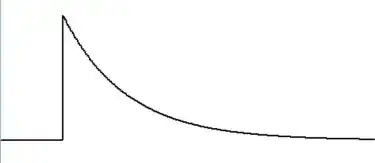Vague one liner:
Laplace Transform is the weight of the forced response of a system for an exponential input $e^{st}$
Answer:
Forget the Laplace Transform for some time. Let’s solve an Ordinary Differential Equation, of the form,
$$y'(t)+ay(t)=x(t)$$
Let $D:\dfrac{d}{dx}$ and $\dfrac{1}{D}:\int_{-\infty}^tdt$, where $D$ is called the Heaviside-Operator, the former is true, only when $f(-\infty) =0$.
Now the ODE can be written as,
$$(D+a)y=x \tag*{...(1)}$$
$$ \implies y=\dfrac{1}{D+a}x$$
So finding the operator $\dfrac{1}{D+a}$ gives us the solution. To do so, consider the following,
$$D[e^{at}\,y(t)]=ae^{at}y(t)+e^{at}D[y(t)]$$
$$D[e^{at}\,y(t)]=e^{at}(D+a)[y(t)]\tag*{...(2)}$$
Now, looking at $(1)$&$(2)$ it's evident that,
$$D[y\,e^{at}]=e^{at}\,x$$
$$y=e^{-at}\dfrac{1}{D}[e^{at}\,x(t)]$$
$$y=e^{-at}\int_{-\infty}^t e^{at}\,x(t)dt$$
$$\implies\dfrac{1}{D+a}[x(t)]=e^{-at}\int_{-\infty}^t e^{at}\,x(t)dt$$
For higher order ODEs, for example a second order ODE,
$$y''(t)+Ay'(t)+By(t)=x(t)$$
$$(D^2+AD+B)[y(t)]=x(t)$$
$$y(t)=\dfrac{1}{D^2+AD+B}[x(t)]$$
$$y(t)=\dfrac{1}{(D+a)(D+b)}[x(t)]$$
which can be operated one after another, or expanded with partial fractions and then considered as two first order systems(superposition). In general,
$$y(t)=H(D)x(t)\tag*{...(3)}$$
We can arrive at the solution, by another way; Convolution. I'm not going to explain convolution in detail, but discuss the results.
$$y(t)=h(t)*x(t)=\int_{-\infty}^{\infty}h(\tau)x(t-\tau)d\tau$$
Where $h(t)$ is the impulse response (input Dirac-Delta) of the system.
Now suppose we express, the input and output functions, $x(t)$ and $y(t)$ in terms of $\delta(t)$.
$$x(t)=X(D)\delta(t)$$
$$y(t)=Y(D)\delta(t)$$
$$(3)\implies Y(D)\delta(t)=H(D)X(D)\delta(t)$$
$$\bbox[5px,border:2px solid red]{Y(D)=H(D)X(D)}$$
So, a convolution in time domain,
$$y(t)=h(t)*x(t)$$
is converted to, multiplication in "operator-domain",
$$Y(D)=H(D)X(D)$$
So, now when we are given a ODE, for an input, $x(t)$ we find the corresponding operator $X(D)$ that gives us $x(t)$ when operated over $\delta(t)$, and find Y(D) by multiplying X(D) and system operator H(D) and hence find $y(t)$ from $Y(D)$. It would be comfortable to form a catalog of X(D) for certain known inputs.
u(t) is step function($u(t) = 1 \text{ for } t>0 \text{ and } 0 \text{ for } t<0$)
$$\begin{array} {|r|r|}\hline \mathbf{x(t)} & \mathbf{X(D)} \\ \hline \delta(t) & 1 \\ \hline u(t) & \dfrac{1}{D} \\ \hline tu(t) & \dfrac{1}{D^2} \\ \hline \dfrac{t^m}{m!}u(t) & \dfrac{1}{D^{m+1}} \\ \hline e^{-rt} & \dfrac{1}{D+r} \\ \hline \cos(\omega_0t)u(t) & \dfrac{D}{D^2+\omega_0^2} \\ \hline \sin(\omega_0t)u(t) & \dfrac{\omega_0}{D^2+\omega_0^2} \\ \hline e^{-\sigma t}\cos(\omega_0t)u(t) & \dfrac{D+\sigma}{(D+\sigma)^2+\omega_0^2} \\ \hline e^{-\sigma t} \sin(\omega_0t)u(t) & \dfrac{\omega_0}{(D+\sigma)^2+\omega_0^2} \\ \hline \end{array} $$
For example, consider this second order ODE
$$y''(t)+3y'(t)+2y=x(t)$$
$$\text{for } x(t)=4\cos(t)\,u(t)$$
$$(D^2+3P+2)[y(t)]=x(t)$$
$$y(t)=\dfrac{1}{D^2+3P+2}x(t)$$
$$\implies H(D)=\dfrac{1}{D^2+3P+2}$$
$$X(D)=\dfrac{D}{D^2+1}\tag*{...refer the catalog}$$
$$\implies Y(D)=\left(\dfrac{1}{D^2+3D+2}\right) \left(\dfrac{4D}{D^2+1}\right)$$
$$Y(D)=\dfrac{4D}{(D+1)(D+2)(D^2+1)}$$
$$Y(D)=\dfrac{-2}{D+1}+\dfrac{8/5}{D+2}+\frac{2}{5}\dfrac{D}{D^2+1}+\frac{2}{5}\dfrac{3}{D^2+1}$$
$$\implies y(t)= -2e^{-t}u(t) + \frac{8}{5}e^{-2t}u(t) + \frac{2}{5} \cos(t)u(t) + \frac{6}{5} \sin(t)u(t)\tag*{...refer catalog}$$
Now, suppose, we provide an input, $x(t)=e^{st}, \, s\in \mathbb{C} , s=\sigma+i\omega$. Finding the response to this input is highly beneficial, because, this complex input encircles many inputs of our catalog. So, if $H(D)$ is the system operator $$y(t)=H(D)x(t)$$
$$X(D)=\dfrac{1}{D-s}$$
$$Y(D)=\dfrac{H(D)}{D-s}$$
$^\dagger$Provided that p=s is not a factor of $H(D)$
$$\dfrac{H(D)}{D-s}= \dfrac{K}{D-s} + Y_n(D)$$
$$(D-s)\dfrac{H(D)}{D-s}\biggr\rvert_{D=s}= K$$
$$\implies K=H(s)$$
$$\therefore Y(D)=\dfrac{H(s)}{D-s}+Y_n(D)$$
$$\implies \bbox[yellow,5px,border:2px solid red]{y(t)=\underbrace{H(s)e^{st}}_{\text{forced response}} + \underbrace{y_n(t)}_{\text{natural response}}} \tag*{...(4)}$$
Now, let's solve the ODE for the same input, with convolution,
$$y(t) = h(t)*x(t)$$
$$y(t)=\int_{-\infty}^{\infty}h(\tau)e^{s(t-\tau)}d\tau$$
$$y(t)=\left(\int_{-\infty}^{\infty}h(\tau)e^{-s\tau}d\tau\right)\,e^{st}$$
$$y(t)=H(s)e^{st}$$
The response of the system is also of the form $e^{st}$ weighted by $H(s)$. This $H(s)$ is also called the Laplace Transform $\mathcal{L[x(t)]}$. So Laplace transform is a special case of this "operator-method".
$$\mathcal{L[h(t)]}=\int_{-\infty}^{\infty}h(t)e^{-st} dt$$
If our system is causal, meaning $h(t)=0$, for $t<0$
$$\implies \mathcal{L[h(t)]}=\int_{0^-}^{\infty}h(t)e^{-st} dt $$
$^\dagger$: This condition, implies that the forced response of the system cannot be calculated with the Laplace transform at the poles.
This actually led me to a question; What does taking Laplace transform on both sides mean?
Reference:
Network Analysis and synthesis by Ali Hajimiri
